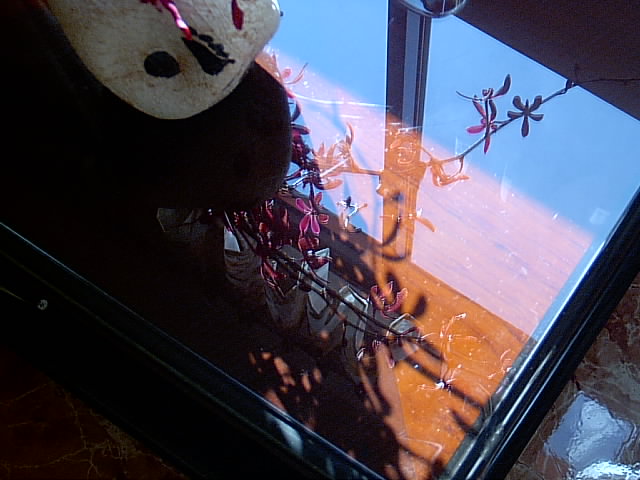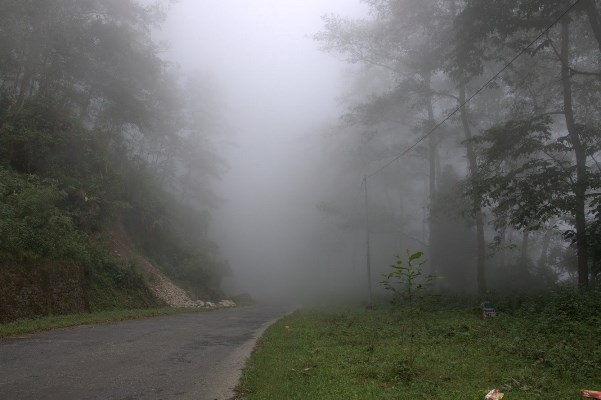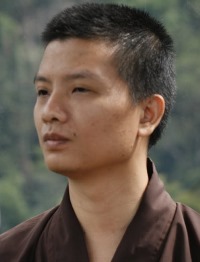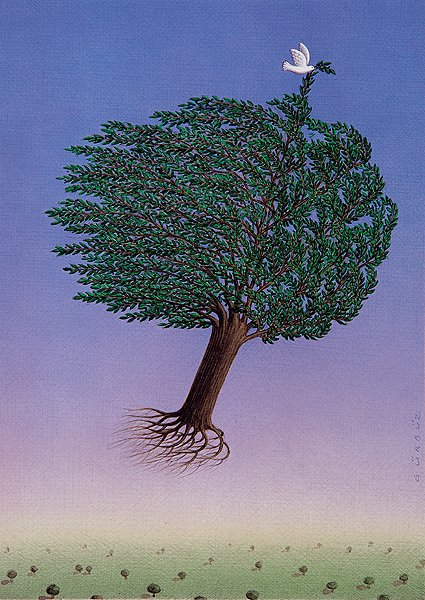Silence (17) - Mai Văn Phấn. Explication par Dr. Ramesh Chandra Mukhopadhyaya. Traduction française Dominique de Miscault
Mai Văn Phấn
Explication par Dr. Ramesh Chandra Mukhopadhyaya
Traduction française Dominique de Miscault

Sự run rảy của cuộc sống - Dominique de Miscault
Silence
17.
Une
gigantesque goutte d'eau
dans un puits
profond
le Concerto
N°1 en do mineur de J.S. Bach
s’engouffre
dans le puits
des gouttes
d'eau
autant de feux
verts
Verts, les
semis de riz
les graines
les bourgeons
de banane
les champs,
jeunes mûriers
C'est la
saison de la chlorophylle
née des
gouttes d'eau
œufs verts
Gonflement
Débordements.
Explication du
Dr Ramesh Chandra Mukhopadhyaya
Le poète dans sa méditation dépasse le
domaine de la conscience et observe dans le puits du subconscient une énorme
goutte d'eau extraordinairement imposante. Cette goutte d'eau extraordinaire
est la Parole. L'eau du puits introduit la Bible, encore et encore. Au début,
il y a la Parole et Dieu dit que la lumière soit, et la lumière fut. En
d'autres termes, le premier souffle du monde ou OM est à l’origine de l'univers
et tout ce qui est relatif aux sens ; aux yeux ou au toucher etc. jaillit de ce
premier souffle. Ainsi, la Parole est goutte. Alors que le poète est immergé
dans son monde intérieur, regardant la Parole tomber comme une gigantesque
goutte, le Concerto No1 en Do mineur de J S Bach s’engouffre dans le puits.
Bien que la Parole soit au plus profond des abysses de l'esprit ou dans le
subconscient, la Parole est aussi dans l'esprit conscient. Ce trésor qui se
trouve dans le monde ne se cache pas du monde. La distinction entre l'esprit et
la matière est superficielle. Le monde des sens dépasse en profondeur la
musique et l'ambroisie[1] qui se cache dans son cœur. C’est à dire que l'esprit
de Bouddha est partout dans le monde comme dans le monde intérieur. Le monde
est cependant agité comme l’allegro, adagio et allegro dans le Concerto de
Bach, ainsi il passe du rapide au lent, puis de nouveau à la rapidité. La vie
fonctionne ainsi, vite ou lentement. Bach est un compositeur baroque. Le terme
« baroque » vient du portugais « barroco » qui signifie « perle irrégulière ».
La vie du monde ou le samsara est baroque. Ici, une ligne se mêle à une autre
pour tisser un réseau compliqué. Quand le poète identifie le monde phénoménal à
la composition de Bach, il peut inconsciemment faire allusion à la théorie des
cordes de la physique moderne. La théorie des cordes pose que tous les objets
de l'univers sont composés de filaments vibrants ou de cordes ou de membranes
d'énergie. Le Concerto de Bach pour Deux Violons en Do mineur montre une
relation subtile entre deux violons. C'est ainsi qu’avec le poète, il y a un
fil ou un sutra parmi les constituants étranges du monde phénoménal. Et le
Concerto No 1 de Bach s’engouffre dans le puits. Les vibrations du monde
phénoménal tombent dans le puits de l'être du poète. Le poète regarde des
petites gouttes d'eau vertes en feu. La couleur verte dans la culture
vietnamienne représente la jalousie et la luxure. La jalousie et la luxure se
répandent dans le puits intérieur du poète mais seront-elles sublimées ? La
jalousie et la convoitise peuvent défier la vie dans le monde phénoménal ou le
samsara. Le samsara vient de la même source que le nirvana. D'où le vert des
plants de riz, les bananes du bananier, la saison de la chlorophylle se
manifeste par les gouttes d'eau vertes en feu lorsqu'elles entrent en contact
avec la goutte d'eau grandiose dans le puits. Dans la mythologie chinoise, le
vert représente le dragon vert qui représente les forces chthoniennes des cinq
formes de la plus haute divinité. C'est le dieu du printemps et de la
fertilité. Le riz est l'ancien symbole de la richesse et de la prospérité de la
santé. Une graine est la vie et la mort, rien et tout, le vide et le samsara en
un. Un seul grain peut engendrer environ mille grains. Il peut rester dans la
paume mais aussi peut dynamiser de grands arbres. Il peut rester stocké pendant
une longue période. Mais chaque fois qu'il se manifeste dans une vie de joie.
Une graine est comme l'univers dans un grain de sable. Les bourgeons de banane
parlent d’eux-mêmes d'humilité et de fertilité, sensualité. Le champ des
mûriers nous rappelle les amoureux Pyrame et Thisbé qui ont péri sous un
mûrier. Un mûrier est donc un symbole sacré pour les amoureux. Les dieux ont
honoré leur amour en changeant définitivement les baies blanches en rouge
sombre. Le champ de mûrier est un idiome. Il parle de transformation et de
changement dans la littérature chinoise. Ce qui était mer devient champ de mûrier.
Mazu ?, une divinité taoïste est associée à l'élixir, elle a vu la mer de l'Est
se transformer en champ mûrier. Notre poète inspiré par Dieu écrit :
C'est la
saison de la chlorophylle
Né des gouttes
d'eau
des œufs
verts.
Les œufs verts symbolisent la graine
Ainsi, le poème exprime le contact entre la
pluie, voix ou la mélodie du monde phénoménal et l’énormité du puits intérieur
de l'esprit peuvent provoquer une saison de chlorophylle sur la terre où tout
gonfle d'amour et de maturité. Tel un monde d'abondance et d'abandon où les
œufs verts gonflent sur le sol. En d'autres termes, le samsara du monde
contingent pourrait se transformer en gonflement d'amour sous un flot de
compassion.
__________
[1] Dans la mythologie grecque, l’ambroisie
est une substance divine, nourriture solide des dieux qui assure leur
immortalité.
Son premier rôle est de nourrir les dieux de
l’Olympe. En effet, ils ne se nourrissent pas de nourriture humaine ni de vin
mais uniquement de nectar qui remplace le vin et d'ambroisie, qui remplace la
nourriture solide, mais n'est pas nécessairement solide elle-même. Chez Homère
celle-ci est apportée par des colombes depuis l'Extrême-Occident, pour nourrir
les chevaux divins.
« La déesse Héra aux bras blancs alors arrêta
ses chevaux, les détela du char. Elle répandit autour une brume abondante et le
Simoïs [fleuve de Troade] pour leur pâture fit lever l'ambroisie. »
Dominique de Miscault:
Artiste Plasticienne. De plages en pages qui se tournent. C’était hier, de 1967 à 1980, mais aussi avant hier, dominiquedemiscault.com. puis de 1981 à 1992. Et encore de 1992 à 2012 bien au delà des frontières. Aujourd’hui, la plage est blanche sous le bleu du soleil.
(http://www.dominiquedemiscault.fr)
Explicated by Dr. Ramesh Chandra Mukhopadhyaya
Translated into French by Dominique de Miscault
Translated into Vietnamese by Phạm Minh Đăng

Sáng sớm ở Bengal Ấn Độ
Maivanphan.com: Nhà thơ - TS. Ramesh Chandra Mukhopadhyaya (từ Calcutta, Ấn Độ) vừa gửi tôi bài chú giải đoạn 17 bài thơ liên khúc “Tĩnh lặng”, rút từ tập thơ “The Selected Poems of Mai Văn Phấn” (Nxb. Hội Nhà văn, 2015) của tôi qua bản tiếng Anh của Nhà thơ Lê Đình Nhất-Lang và Nhà thơ Susan Blanshard. Sau khi TS. Ramesh công bố bài chú giải trên mạng Sefirah (Ấn Độ), Nhà thơ - Nghệ sỹ Pháp Dominique de Miscault đã dịch bài chú giải sang tiếng Pháp. Xin được bầy tỏ lòng biết ơn sâu sắc nhất của tôi tới Nhà thơ - TS. Ramesh Chandra Mukhopadhyaya và Nhà thơ - Nghệ sỹ Dominique de Miscault đã dành thời gian và tâm huyết cho bài chú giải này! Trân trọng giới thiệu với bạn yêu thơ bài chú giải qua bản dịch của Phạm Minh Đăng.
Poet - Doctor Ramesh Chandra Mukhopadhyaya (from Calcutta, India) just sent me a explication on the 17nd paragraph of the long poem "Silence" selected from my poetry book “The Selected Poems of Mai Văn Phấn” (Publishing House of The Vietnam Writer’s Association, 2015) through the English version by Poet Nhat-Lang Le & Poet Susan Blanshard. Right after Dr. Ramesh published an explication on Sefirah groups website (India), Poet - Artist Dominique de Miscault translated the paragraph into French. I would like to express my deepest gratefulness for Poet - Dr. Ramesh Chandra Mukhopadhyaya and Poet - Artist Dominique de Miscault for having spent time and devotion on the translation for this brilliant explication! I would like to respectfully introduce to poetry lovers the explication through the translated version by Phạm Minh Đăng.
Silence
17.
A grandiose drop of water
Lying in a deep well
Concerto No. 1 in D minor by J.S. Bach
Falls into the well
Small drops of water
Carry green light
The green of rice seedlings
Seeds
Banana buds
A field of young mulberry
It’s the season of chlorophyll
Born out of water drops
In the shape of green eggs
Swelling
Overflowing the ground.
(Translated from Vietnamese by Nhat-Lang Le & Susan Blanshard)
Explication
The poet in his meditation goes below his conscious mind and espies in the well of the subconscious a grandiose drop of water or a drop of water extravagantly imposing in appearance. The drop of water extravagantly imposing is but the Word. The water in the well denotes the Word in the Bible over and over again. In the beginning there was Word and God said Let there be light there was light. In other words the primordial rhythm or the OM is at bottom of the universe and whatever is tangible to the senses, to the eyes or to the touch etc springs from the overmind rhythm. So the Word is espied as a grandiose drop. While the poet is immersed in the inward world looking at the Word as a grandiose drop, right then Concerto No 1 in Dminor by J S Bach falls in the well. While there is the Word in the deeper recesses of the mind or in the subconscious mind there is the Word in the conscious mind as well. That is, the same treasure that is found in the world without, lurks in the world within. The distinction between mind and matter is superficial. The world of senses pour into the very depth of one’s heart the very music and ambrosia that lurks in one’s heart. That indicates that there is the Buddha mind everywhere, in the world without and in the world within. The world without is apparently restless however. That is why Bach’s Concerto has allegro adagio and allegro. That is why it shifts from brisk speed to slow speed and then to brisk speed again. Worldly life is something like that, now in haste and now calm. Bach is a baroque composer. The word baroque means a shapeless pearl. The worldly life or samsara is shapeless indeed or baroque. Here one line mingles with another to weave a complicated network. When the poet symbolizes the phenomenal world in terms of Bach’s composition he perhaps unconsciously alludes to the String theory of modern Physics. String theory posits that all objects of the universe is made of vibrating filaments or strings or membranes of energy. And Bach’s Concerto for Two Violins in D minor show subtle relation between two violins. That is how, with the poet, there is a thread or sutra among the bizarre constituents of the phenomenal world. And the Concerto No 1 by Bach falls in the well. The vibrations of the phenomenal world fall into the well of the poet’s being. The poet finds small drops of water carrying green light. Green colour in Vietnamese culture stands for jealousy and lust. Do jealousy and lust pour into the inner well of the poet and get sublimated? Because jealousy and, lust could stand for lust for life in the phenomenal world or samsara. The samsara also springs from the same source as nirvana. Hence the green of the rice seedlings banana buds the season of chlorophylls manifest from the green waterdrops when they come in contact with the grandiose water drop in the well. In Chinese mythology green stands for the green dragon that stands for the chthonic forces of the five forms of the Highest Deity. It is a god of Spring and fertility. Rice is the ancient symbol of health wealth and prosperity. A seed is life and death, nothing and everything, the void and samsara in one. It is a single grain and yet it can bring about thousand grains. It can remain in the palm and it can bring about vibrant life in tall trees. It can remain stored for a long time. But any time it can be manifest in blithe life. A seed is as it were the universe in a grain of sand. Banana buds speak of humility fertility and. sensuality. The field of mulberry trees remind us of the star crossed lovers of Pyramus and Thisbe who perished under the mulberry tree. A mulberry tree is thus the symbol of sacrice made by lovers. The gods honour their love by turning the white berries red permanently. But mulberry field is an idiom. It speaks of transformation and change in Chinese literature. What was once a sea became a mulberry field. Magu a Taoist god associated with elixir pointed out that he had seen the Eastern Sea turn into mulberry field. Our god inspired poet observes
It’s the season of chlorophyll
Born out of water drops
In the shape of green eggs.
Green eggs here could stand for the seed.
Thus the poem sums up how the contact between the rain of the voice or melody of the phenomenal world and the grandiose drop in the inner well of mind could bring about a season of chlorophyll upon the earth where every thing swells with love and ripeness. It would be a world of abundance and abandon where green eggs swell over the ground. In other words the s amsara of the contingent world could be transformed swelling with love under the impact of a flood of compassion.
Tĩnh lặng (17) của Mai Văn Phấn
Ramesh Chandra Mukhopadhyaya chú giải
Phạm Minh Đăng dịch sang tiếng Việt

Dịch giả Phạm Minh Đăng
Tĩnh lặng
17.
Giọt nước lớn
Nằm trong giếng sâu
Bản Concerto I cung Rê thứ của J. S. Bach*
Rơi vào lòng giếng
Những hạt nước nhỏ
Mang ánh sáng xanh
Màu xanh lá mạ
Đọt mầm
Nõn chuối
Bãi dâu non
Mùa diệp lục
Sinh từ hạt nước
Hình những quả trứng xanh
Dâng
Tràn lên mặt đất.
___________
* Johann Sebastian Bach (1685-1750), nhà soạn nhạc người Đức.
Chú giải
Nhà thơ trong trạng thái thiền định của mình chìm dưới [lớp] tâm trí tỉnh thức và chợt thấy trong lòng giếng tiềm thức một giọt nước lớn hay giọt nước có hình dạng ngoại cỡ một cách vô lý. Giọt nước có hình dạng ngoại cỡ đó là Lời. Nước trong giếng ngoại cỡ một cách vô lý biểu lộ Lời trong Thánh Kinh được nhắc lại nhiều lần. Khởi thủy là Lời và Đức Chúa trời phán rằng: Phải có sự sáng, thì có sự sáng. Trong diễn đạt khác, giai điệu sơ khởi hay âm OM ở dưới đáy của vũ trụ và điều gì hữu hình có thể nhận biết được, thấy được hoặc chạm được… đều phát sinh từ giai điệu chủ đạo. Vậy nên Lời được thấy như một giọt nước lớn. Khi nhà thơ chìm đắm trong thế giới nội tại, nhìn thấy Lời như một giọt nước lớn, thì cùng lúc bản hợp tấu số 1 cung Rê thứ của Bach rơi vào lòng giếng. Khi tồn tại Lời ở những rãnh sâu hơn nữa trong tâm trí hay trong tiềm thức thì cũng tồn tại Lời trong tâm trí tỉnh thức. Nghĩa là cùng một của kho vừa được tìm thấy nơi thế giới ngoài kia, vừa đang ẩn giấu ở thế giới trong này. Sự khác biệt giữa tâm và vật chỉ là bề ngoài.
Thế giới của sự tri giác đổ vào nơi sâu thẳm tim người với âm nhạc và dưỡng chất ẩn chứa nơi đó. Cũng thấy là có tâm trí Phật mọi nơi, ở thế giới ngoài kia và và thế giới trong này. Thế giới ngoài kia như thể còn không ngơi nghỉ. Đó là lí do bản hợp tấu của Bach có nhịp thong thả vui tươi và tương đối nhanh. Đó là lí do bản nhạc chuyển từ tốc độ nhanh về chậm và rồi nhanh trở lại. Cuộc sống tại thế có điều gì giống vậy, lúc vội vã lúc bình tâm. Bach là một nhà soạn nhạc baroque. Từ “baroque” mang nghĩa “hòn ngọc thô”. Cuộc sống tại thế hay luân hồi vốn không có hình dạng thực chất, cũng là baroque. Nơi đây từng dòng hòa trộn với nhau dệt nên một mạng lưới phức hợp. Khi nhà thơ biểu tượng hóa thế giới hiện tượng vào sáng tác của Bach, ông có lẽ đã gợi nhắc một cách vô thức tới lý thuyết Dây trong Vật lý hiện đại. Lý thuyết Dây giả thuyết rằng tất cả vật thể trong vũ trụ được tạo thành từ các dây dao động, hoặc các mạng năng lượng. Và bản hợp tấu của Bach cho hai cây đàn violin cung Rê thứ thể hiện mối quan hệ tinh tế giữa hai cây đàn violin. Đó là cách, với nhà thơ, có một sợi dây hay lời Kinh [sutra] giữa các phần tử kì dị của thế giới hiện tượng. Và bản hợp tấu số 1 của Bach rơi vào lòng giếng. Sự rung động từ thế giới hiện tượng rơi vào lòng giếng của sự tồn hiện của nhà thơ.
Nhà thơ nhận thấy những giọt nước nhỏ mang ánh sáng xanh. Màu xanh lục trong văn hóa Việt biểu tượng cho sự ghen tuông và ham muốn. Có phải sự ghen tuông và ham muốn đã đổ vào giếng nội tại của nhà thơ và thăng hoa? Vì sự ghen tuông và ham muốn có thể biểu trưng cho sự ham muốn sự sống trong thế giới hiện tượng hay luân hồi. Luân hồi cùng đơm nhánh từ chung nguồn với niết bàn. Vì vậy màu xanh lá mạ, của đọt chuối non, mùa diệp lục tuyên sinh từ những giọt nước màu lục khi chúng va chạm với những giọt nước lớn rơi lòng giếng. Theo thần thoại Trung Quốc, màu xanh lục gợi nhắc tới biểu tượng rồng xanh, đại diện cho các sức mạnh huyền bí trong năm thức của Vị Thần tối cao. Cũng là vị Chúa của mùa xuân và sinh nở. Thóc là biểu tượng cổ xưa cho sức khỏe dồi dào và thịnh vượng. Một hạt mầm là sự sống và cái chết, là không gì và là tất cả, là khoảng trống và cũng là luân hồi. Hạt mầm có thể chỉ là một hạt mà cũng có thể chứa hàng ngàn hạt trong một. Nó có thể nhỏ gọn lòng tay và cũng có thể mang đến sự sống dâng trào thành nhiều cây cao. Hạt mầm có thể tiềm sinh rất lâu. Nhưng bất kì lúc nào nó cũng có thể bật mầm bám vào cuộc sống tươi vui. Một hạt mầm cũng tựa thể một vũ trụ trong một hạt cát. Các đọt chuối nói về sự khiêm nhường, sinh sôi và nhục cảm.
Cánh đồng dâu gợi nhắc ta về đôi tình nhân Pyramus và Thisbe đã chết dưới gốc dâu. Cây dâu vì đó mang biểu tượng sự tuẫn nạn của những kẻ yêu. Các vị thần ca ngợi tình yêu của họ bằng cách biến những cây dâu trắng thành đỏ mãi mãi. Nhưng cánh đồng dâu là một cách nói. Biểu tượng nói về sự chuyển hóa và đổi thay trong văn học Trung Quốc bãi bể nương dâu. Ma Cô (麻姑 – Magu), một đạo sĩ gắn với thuốc trường sinh nói rằng mình đã thấy biển Đông biến thành cánh đồng dâu. Nhà thơ thần hứng của ta đã thấy điều đó.
Mùa diệp lục
Sinh từ hạt nước
Hình những quả trứng xanh
Những quả trứng xanh ở đây như những hạt mầm.
Theo đó bài thơ cuối cùng chỉ ra sự kết nối giữa cơn mưa âm thanh hay giai điệu của thế giới hiện tượng với giọt nước lớn trong lòng giếng của tâm tưởng có thể mang tới một mùa diệp lục trên trái đất nơi mọi vật đắm chìm trong tình yêu và nỗi chín. Đó cũng là một thế giới của phong nhiêu và hoang phế nơi những quả trứng xanh đầy tràn mặt đất. Theo cách khác, sự luân hồi trong thế giới bất định có thể đang chuyển hóa tràn dâng với tình yêu sinh ra trong những cơn nước dâng đầy từ bi.
Tĩnh lặng - Silence (1)
Tĩnh lặng - Silence (2)
Tĩnh lặng - Silence (3)
Tĩnh lặng - Silence (4)
Tĩnh lặng - Silence (5)
Tĩnh lặng - Silence (6)
Tĩnh lặng - Silence (7)
Tĩnh lặng - Silence (8)
Tĩnh lặng - Silence (9)
Tĩnh lặng - Silence (10)
Tĩnh lặng - Silence (11)
Tĩnh lặng - Silence (12)
Tĩnh lặng - Silence (13)
Tĩnh lặng - Silence (14)
Tĩnh lặng - Silence (15)
Tĩnh lặng - Silence (16)
Biography of Dr. Ramesh Chandra Mukhopadhyaya
Address: 6/ 1 Amrita Lal Nath lane P.0. Belur Math Dist Howrah West Bengal India Pin code711202. Date of Birth 11 02 1947. Education M.A [ triple] M Phil Ph D Sutrapitaka tirtha plus degree in homeopathy. He remains a retired teacher of B.B. College, Asansol, India. He has published books in different academic fields including religion, sociology, literature, economics, politics and so on. Most of his books have been written in vernacular i.e. Bengali. Was awarded gold medal by the University of Calcutta for studies in modern Bengali drama.
Tiểu sử Tiến sĩ Ramesh Chandra Mukhopadhyaya
Địa chỉ: 6/ 1 đường Amrita Lal Nath hòm thư Belur Math Dist Howrah Tây Bengal Ấn Độ mã số 711202. Ngày sinh: 11 02 1947. Thạc sĩ văn chương, thạc sĩ triết học, tiến sĩ triết học [bộ ba] cùng với Bằng y học về phép chữa vi lượng đồng cân. Ông còn là một giảng viên đã nghỉ hưu của Trường đại học B.B, Asansol, Ấn Độ. Ông đã có những cuốn sách được xuất bản về nhiều lĩnh vực học thuật bao gồm tôn giáo, xã hội học, văn học, kinh tế, chính trị v.v. Hầu hết sách của ông đã được viết bằng tiếng bản địa là tiếng Bengal. Ông đã được tặng thưởng huy chương vàng của Trường đại học Calcutta về các nghiên cứu nghệ thuật sân khấu Bengal hiện đại.

Tranh của Họa sỹ Gürbüz Doğan Ekşioğlu, Thổ Nhĩ Kỳ